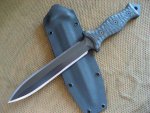AK264,
I may be missing your point, but I don't really think you are asking for a definition of "fighting" as websters, or wikipedia can easily do that. I think what you are looking for is more closely related to "rules", regulations, legal decisions and similar things regarding the use of force.
The short version of what is taught at most police academy classes is this: If the level of force used is justified, the means of application is of no consequence. In otherwords, if you are justified in using deadly force, it doesn't matter whether you used a firearm, knife, shovel, sharpened stick, or a rock. The really difficult thing is understanding all the legal decisions in both local, and larger jurisdictions. If you aren't justified in using deadly force, I would think you would have a very difficult time convincing a jury that a knife is a lower level of force than a firearm.
There are many factors that determine whether or not you or I would be justified in going to the next higher level of force when we become involved in an altercation, or fight. If I was 6'4" tall and weighed 245 pounds, 25 years old, and in great shape, I would have a hard time convincing a jury that I needed to go to a higher level of force against someone who was 5'3" tall weighing 125 pounds at 65 years old and feeble. However, if the small, feeble, old person is wielding a knife or club, you might be justified in going to a higher level of force than simply hands on. Some of the commonly considered factors:
1. my size and fitness compared to the other person's
2. if the other person has a weapon, how dangerous is it? (a piece of garden hose or a 4' long Scottish claymore)
3. my level of experience compared to the other person (am I a black belt fighting someone with no experience?)
4. do we both have a legal reason to be there?
5. who started it?
6. is there some reason I should submit to the other person's demand (such as a police officer, or the property owner)
7. does the other person have the means, ability, and intent to harm me? (all 3 need to be present)
there are many, MANY other considerations, but this lets you know the things to consider.
The classes on use of force rules, application of them, report writing, relevant legal decisions, and related items takes days to teach at the police academy. So it isn't something that can be written out in a few paragraphs on this forum.
I have much respect for people who are willing ask about these items, and feel that they deserve better than many of the snarky, or smart assed responses these sorts of questions often receive. If you are really interested in finding out more about use of force, you will find it confusing, and enlightening. People who have to make instant life or death decisions about use of deadly force issues risk everything they have on a decision that has to be made instantly, and under incredible pressure.
I have been fortunate enough that my decisions haven't been bad ones (so far). The "what if" questions about these decisions will plague both the sleep and waking hours of those who have had to make these decisions.










